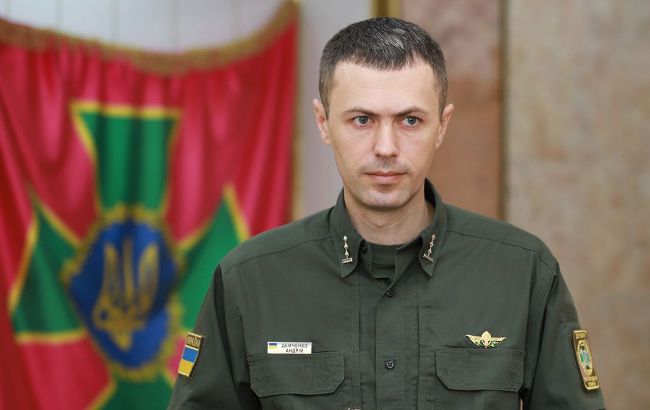Only 1 out of 4 largest border crossings with Poland not blocked - Ukraine's Border Service Spokesperson
 Andrii Demchenko, Spokesperson for the State Border Guard Service of Ukraine (facebook.com)
Andrii Demchenko, Spokesperson for the State Border Guard Service of Ukraine (facebook.com)
In an interview with RBC-Ukraine, Andrii Demchenko, Spokesperson for the State Border Guard Service of Ukraine, discussed the situation at the Ukraine-Poland border, following the announcement by Polish farmers of a blockade of all border crossings and alternative routes for Ukrainian trucks.
When it comes to the demands of Polish farmers, does the State Border Guard Service have such information?
Actually, we do not receive information at an official level. The information we have from our Polish colleagues is exclusively about the intentions or actions taken by Polish farmers. However, from open sources, we see that they are protesting against the uncontrolled influx of goods into Poland from Ukraine.
Polish farmers announced a complete blockade of the Ukraine border yesterday. Have Polish border guards already informed the SBGS?
We have not received any information from Polish border guards about February 20. However, one should understand that they are currently taking action in five directions, with a total of nine border crossings with Poland. Each of these crossings may have its peculiarities when it comes to the passage of freight transport. Some routes, according to agreements with Poland, may allow trucks weighing over 7.5 tons to cross, some may only allow empty trucks, and some may allow trucks with cargo weighing less than 7.5 tons.
If Polish farmers do carry out the announced blockade, what could be the situation at the Ukrainian border?
On the routes they are already blocking, they significantly restrict the crossing of the border by freight transport. The largest border crossings with Poland are Shehyni, Rava-Ruska, Yahodyn, and Krakovets, where trucks weighing over 7.5 tons can cross the border, three of them are already blocked today.
At the moment, only Krakovets is not blocked, but yesterday Polish farmers blocked it for about an hour. Therefore, one can say that today the crossing of the border by trucks is already significantly restricted.

Polish protests (Vitalii Nosach, RBC-Ukraine)
Are Polish farmers only blocking entry into Poland, or are they also blocking exit?
Once again, the situation may vary at each crossing. They restrict movement both into Poland and from Poland towards Ukraine. However, they mostly limit the entry of trucks into Poland from Ukraine.
For example, let's talk about Yahodyn. Before the blockade, it was crossed by 1200-1400 trucks in both directions per day. Over the last day, only 146 trucks crossed it, 14 of which were heading towards Poland. The day before, 95 trucks crossed, 7 of which were heading towards Poland.
For instance, when it comes to Shehyni, over the last day, 72 trucks crossed, all towards Ukraine. None towards Poland. The Polish side did not allow any.
What is the current situation with queues at the Ukraine-Poland border?
In terms of queues, as of this morning (February 14), approximately 1300 freight vehicles are waiting in queues at the blocked border crossings. The largest queues are at Yahodyn and Rava-Ruska. For example, at the Ustyluh border crossing, there were no queues on the Polish side towards Ukraine, while at the Uhryniv crossing, 100 vehicles were waiting.
There is also the Krakivets direction, which is currently not blocked, except for yesterday's hour-long actions. As of this morning, over 1100 freight vehicles were waiting on the Polish side towards Ukraine at the Krakivets crossing. The queue here is significant as carriers seek opportunities to cross the border.
Are there queues for entry into Poland from the Ukrainian side?
From the Ukrainian side, there is an online queue managing system called eQueue. You can check the status on the eQueue website, but adjustments are ongoing as drivers avoid blocked routes and register more for the Krakovets direction.
Physically, drivers don't have to stand in kilometers-long queues at the border. They can wait elsewhere in convenient locations, and the administrators of eQueue inform them of the day and time when they can cross the border.
Are there alternative routes for trucks, besides Krakivets, to bypass the blocked border crossings?
As mentioned, there are four main border crossings with Poland, and only one is not blocked. The other crossings have various characteristics, but none are suitable for large trucks to cross. Essentially, Krakovets remains the only direction for large trucks.
Fortunately, the situation is calm on other sections of the border with neighboring countries, with no restrictions or significant queues.

Queues at the border (Vitalii Nosach, RBC-Ukraine)
What's the situation at the border with Hungary? Previously, Hungarian farmers also announced protests at the border with Ukraine.
On February 9, when Polish farmers began their blockade, we also had information from our Hungarian colleagues that Hungarian farmers intended to hold a demonstration near the border. This action took place at the Zahon border crossing, but it did not block truck traffic then, and it hasn't since.
Do the blockades by Polish farmers affect cars and buses?
Fortunately, no. Other types of transport cross the border freely in both directions. The only issue we observed was a partial traffic slowdown for cars and buses on the Polish side at the Shehyni border crossing, possibly due to some uncoordinated actions between the organizers and participants of the protest. But it lasted only a few hours. Today, the movement is normal.
Can you provide advice to drivers about the border situation?
Once again, when it comes to cars and buses, there are currently no restrictions on movement. There's a lot of information that the border is blocked even for ordinary citizens. Not true.
First and foremost, it's essential to rely on information from government agencies responsible for these directions. Specifically, the State Border Guard Service and Customs Service, whose websites provide information about the situation at border crossings. If there are complications for any category of transport, we inform citizens.

